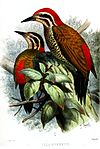Superregnum: Eukaryota
Regnum: Animalia
Subregnum: Eumetazoa
Cladus: Bilateria
Cladus: Nephrozoa
Superphylum: Deuterostomia
Phylum: Chordata
Cladus: Craniata
Subphylum: Vertebrata
Infraphylum: Gnathostomata
Superclassis: Tetrapoda
Cladus: Reptiliomorpha
Cladus: Amniota
Classis: Reptilia
Cladus: Eureptilia
Cladus: Romeriida
Subclassis: Diapsida
Cladus: Sauria
Infraclassis: Archosauromorpha
Cladus: Crurotarsi
Divisio: Archosauria
Subsectio: Ornithodira
Subtaxon: Dinosauromorpha
Cladus: Dinosauria
Ordo: Saurischia
Cladus: Theropoda
Cladus: Neotheropoda
Infraclassis: Aves
Cladus: Euavialae
Cladus: Avebrevicauda
Cladus: Pygostylia
Cladus: Ornithothoraces
Cladus: Euornithes
Cladus: Ornithuromorpha
Cladus: Ornithurae
Cladus: Carinatae
Parvclassis: Neornithes
Cohors: Neognathae
Ordo: Piciformes
Familia: Picidae
Subfamilia: Picinae
Genus: Dinopium
Species: D. benghalense – D. everetti – D. javanense – D. psarodes – D. rafflesii - D. shorii
D. benghalense - D. javanense - D. rafflesii -
Name
Dinopium Rafinesque, 1814
Typus
Picus javanensis Ljungh, 1797 = Dinopium javanense
References
Principes Fondamentaux de Somiologie. p.2
Fernando, S.P., Irwin, D.E. & Seneviratne, S.S. 2015. Phenotypic and genetic analysis support distinct species status of the Red-backed Woodpecker (Lesser Sri Lanka Flameback: Dinopium psarodes) of Sri Lanka. The Auk 133(3):497-511. DOI: 10.1642/AUK-15-233.1 Reference page.
Dinopium is a genus of birds in the woodpecker family Picidae. The species are found in South and Southeast Asia.
The genus was introduced by the French polymath Constantine Samuel Rafinesque in 1814 to accommodate the common flameback (Dinopium javanense).[1][2] The name combines the Classical Greek deinos meaning "mighty" or "huge" and ōps/ōpos meaning "appearance".[3]
A large phylogenetic study of the woodpecker family Picidae published in 2017 found that the genus was paraphyletic. The olive-backed woodpecker (Dinopium rafflesii) is more closely related to the pale-headed woodpecker (Gecinulus grantia) than it is to other members of the genus Dinopium.[4]
Species
As presently constituted, the genus contains the following 5 species:[5]
| Image | Scientific name | Common Name | Distribution |
|---|---|---|---|
 |
Dinopium shorii | Himalayan flameback | Bangladesh, Bhutan, India, Myanmar, and Nepal |
 |
Dinopium javanense | Common flameback | Bangladesh, Brunei, Cambodia, China, India, Indonesia, Laos, Malaysia, Myanmar, Singapore, Thailand, and Vietnam |
 |
Dinopium everetti | Spot-throated flameback | island of Palawan in the Philippines. |
 |
Dinopium benghalense | Black-rumped flameback | Pakistan, India south of the Himalayas and east till the western Assam valley and Meghalaya, Bangladesh and Sri Lanka |
 |
Dinopium psarodes | Red-backed flameback | Sri Lanka |
Taxon identifiers
Wikidata: Q148764 Wikispecies: Dinopium BOLD: 115472 GBIF: 5228802 iNaturalist: 18371 ITIS: 553534 NCBI: 367956 Plazi: 64C031D8-EBBE-C5BA-4558-28AE773FE8B5 ZooBank: 26534555-C95A-4954-8181-1FA6967AE213
References
Rafinesque, Constantine Samuel (1814). Principes Fondamentaux de Somiologie (in French). Palerme. Inside front cover.
Peters, James Lee, ed. (1948). Check-List of Birds of the World. Volume 6. Cambridge, Massachusetts: Harvard University Press. p. 143.
Jobling, James A. (2010). The Helm Dictionary of Scientific Bird Names. London: Christopher Helm. p. 136. ISBN 978-1-4081-2501-4.
Shakya, S.B.; Fuchs, J.; Pons, J.-M.; Sheldon, F.H. (2017). "Tapping the woodpecker tree for evolutionary insight". Molecular Phylogenetics and Evolution. 116: 182–191. doi:10.1016/j.ympev.2017.09.005. PMID 28890006.
Gill, Frank; Donsker, David; Rasmussen, Pamela, eds. (2020). "Woodpeckers". IOC World Bird List Version 10.1. International Ornithologists' Union. Retrieved 17 May 2020.
Retrieved from "http://en.wikipedia.org/"
All text is available under the terms of the GNU Free Documentation License

